March 2003
Data
From iaslash:
“The current media spectacle that is the ‘war on Iraq’ produces a lot of good and bad infographics. I was surfing the web looking for them and a few thoughts struck me:
Infographics are somewhat expensive and time-consuming to produce, and are therefore in their nature providing context to whatever is going on on the ground. It is, however, _not_ in their nature to provide afterthought and analysis.
The policy concerning infographics of NRK (Norwegian equivalent of the BBC) is that it is important to not overuse infographics because they can create the impression that this is a computer game and not real war with real people really being blown into little pieces.”
...
This MSNBC graphic on the number of U.S. and U.K. deaths in Iraq is an improvement on this chart
|
The maintainers of Iraqbodycount.net comb the media and publish an estimate of Iraqi casualties via a banner you can include on your Web page. A number of bloggers have picked it up, but the raw numbers, particularly in this layout, just read like a score.
On the flip side are the graphic photos of U.S. and Iraqi corpses [warning: strong content] you won’t see on CNN. The images overwhelm with horror.
Yet, to me neither are as heart rending as this list of names, ages, and U.S. hometowns.
Together for the City We Love
![]() In February 1975, New York City reached the nadir of its financial crisis when underwriters withdrew from a $260 million bond issue, putting the the City on the verge of insolvency. To help generate income, the New York Commerce Commission hired ad agency Wells, Rich and Greene to develop a campaign that would promote New York City and state as a tourist destination. The slogan they came up with: I Love New York. The Commission hired designer Milton Glaser to develop a logo. When the ads came out in 1977, they featured New York celebrities including Frank Sinatra, Morgan Fairchild and Yul Brenner.
In February 1975, New York City reached the nadir of its financial crisis when underwriters withdrew from a $260 million bond issue, putting the the City on the verge of insolvency. To help generate income, the New York Commerce Commission hired ad agency Wells, Rich and Greene to develop a campaign that would promote New York City and state as a tourist destination. The slogan they came up with: I Love New York. The Commission hired designer Milton Glaser to develop a logo. When the ads came out in 1977, they featured New York celebrities including Frank Sinatra, Morgan Fairchild and Yul Brenner.
The campaign was an enormous success, running for 25 years, with no end in sight. (There’s certainly no shortage of fabulous I Love New York merchandise for sale around town.) The logo has become iconic and often imitated.
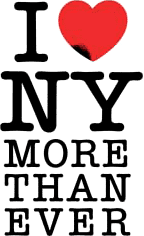 In the aftermath of September 11, 2001, Glaser updated his design by adding a smudge to the lower corner of the heart and the words “More Than Ever.” The image must have struck a chord. It seemed to pop up in every shop window in town. Glaser, who’s taught design at the School of Visual Arts for 40 years, worked with the director of the school to print up posters. Students ran around handing out 5,000 posters, and New York’s papers reprinted the image for their readers to clip and post. Personally, I thought the image was corny, but a step up from all the flag waving. I did experience the incredible comradery of the people of New York City. Many, however, experienced incredible animosity and even violence.
In the aftermath of September 11, 2001, Glaser updated his design by adding a smudge to the lower corner of the heart and the words “More Than Ever.” The image must have struck a chord. It seemed to pop up in every shop window in town. Glaser, who’s taught design at the School of Visual Arts for 40 years, worked with the director of the school to print up posters. Students ran around handing out 5,000 posters, and New York’s papers reprinted the image for their readers to clip and post. Personally, I thought the image was corny, but a step up from all the flag waving. I did experience the incredible comradery of the people of New York City. Many, however, experienced incredible animosity and even violence.
At the bottom of the posters is text that specifically notes that the posters are not for sale. Glaser did make one exception, though, when he allowed WNYC, a public radio station, to sell posters to raise money to replace the broadcast tower and antenna that were destroyed when the towers collapsed. The gesture ultimately raised $190,000.
It’s a year and a half later and the city faces another financial crisis. Glaser has designed the third in a continuing series of messages: “Together for the City We Love.”
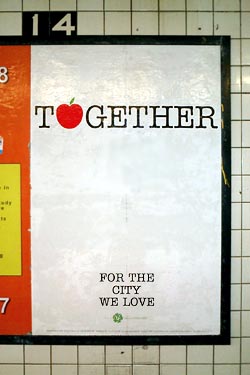 Glaser told the Daily News:
Glaser told the Daily News:
“His new phrase was inspired by the city’s fiscal crisis and the recent threat of a transit strike. Glaser sent City Hall several designs with the slogan, which he says could serve as a ‘rallying cry’ to help New Yorkers bond during tough times.”
When I first saw the new logo in the subway, I was skeptical. As a New Yorker, I will not be bullied into happiness or togetherness. Certainly, when the State sells unity, I wonder who stands to gain. “Community” is often used the gloss over difference and dissent. “You’re either with us, or against us.”
The design, however, is open to interpretation. One could just as easily use it at a block party or mass action. And I’m sure subway riders will note their own impressions on the ad’s generous white space.
As it turns out, the city chose not to use the design. Instead, Glaser and SVA will be publishing it on their own again — the public act of private individual, an educational institution, and its students. SVA also arranged ad space in the subways. The students will distribute the printed posters this weekend.
“The people of NYC seem to be losing that sense of cohesion we felt a year and a half ago,” says Glaser. He hopes the campaign will encourage people to be nicer to each other and may try to use it as a fundraiser for the City to help pay for some of the services being cut. “It’s a drop in the bucket, but it would have symbolic meaning.”
Meanwhile, the city government has plans of its own. Mayor Bloomberg has set up a permanent office and campaign to sell New York to big business and investors and to woo major events. The effort relies less on advertising and more on deals with the private sector and behind-the-scenes lobbying.
It has already brought back Grammy’s and next year’s WNBA All-Star game to New York, but also the Republican National Convention in 2004.
I for one will be out there protesting, together for the city we love.
Under the Asphalt, the Cobblestones

Protestors after the march in New York City yesterday chalked messages around Washington Square Park.
As the U.S. invades Iraq and activists around the world take to the streets, here in New York I’m noticing how the city itself is increasingly used as a medium by the anti-war movement.
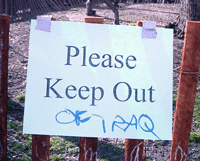 Much of this is nothing new. City streets have always been checkered with posters, graffiti, flyers, and stickers. Subway ads are often annotated with running commentary, sometimes sexual but just as often critical of the ad and advertiser itself (or just blacked out teeth on a too-cheerful model.)
Much of this is nothing new. City streets have always been checkered with posters, graffiti, flyers, and stickers. Subway ads are often annotated with running commentary, sometimes sexual but just as often critical of the ad and advertiser itself (or just blacked out teeth on a too-cheerful model.)
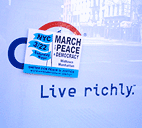 The anti-war movement has taken advantage of all of this. United for Peace and Justice stickers seem to be everywhere — on pay phones, mailboxes, street lamps, walls, and signage. The letters “STOP BUS” on the street are altered to read “STOP BUSH.” In the Baghdad Snapshot Action activists have simply postered ordinary snapshots from Iraq: “Quiet and casual, the snapshots show a part of Baghdad we rarely see: the part with people in it.”
The anti-war movement has taken advantage of all of this. United for Peace and Justice stickers seem to be everywhere — on pay phones, mailboxes, street lamps, walls, and signage. The letters “STOP BUS” on the street are altered to read “STOP BUSH.” In the Baghdad Snapshot Action activists have simply postered ordinary snapshots from Iraq: “Quiet and casual, the snapshots show a part of Baghdad we rarely see: the part with people in it.”
And then there was the march of over 200,000 people down midtown Manhattan yesterday.
But as the war escalates, so do the protests. And so does the reconfiguring of public space. Activists in San Francisco last week shut down traffic throughout the city with autonomous direct actions coordinated online. Activists hauled newspaper kiosks, cafe chairs and tables, and other street furniture into the streets. [article and photos]
What will be the government’s response? Some communities are all too familiar with locked down, fenced in, and video monitored public spaces. Once considered an invasion of privacy, cameras and other measures are increasingly justified as a legitimate response to terrorism. In the name of anti-terrorism, the City recently sought and won a loosening of the law that restricted on police surveillance of political groups. The restrictions were imposed by the settlement of a 1971 lawsuit over harassment of political advocacy groups by the Police Department’s so-called “Red Squad.”
Public amenities and the details of public life are being reshaped elsewhere in the fight against terrorism. In Israel, seating at bus stops is often bolted to the wall (no chair legs to hide things behind), every turnstile will soon have a metal detector installed, and every trash can on the street will be replaced with see-through plastic and wire receptacle. In Washington, D.C., subway trash cans are being replaced with bomb-resistant models. In the Tokyo subway, there are no trash cans at all anymore.
Not to mention Israel’s wall.
This week New York City announced Operation Atlas, additional security measures to try to protect us against terrorist attack during wartime. I’m not opposed to greater inspection of cargo entering the City, but have no doubt that the NYPD will use their new powers to target activists and political dissent. I also note that the plan, which costs $5 million a week comes at a time of severe budget cuts in NYC — and a deficit of nearly $4 billion. Was factored into the costs of the war?
Literature on cities is replete with the metaphor of public space as the site and the physical embodiment of democracy. In the weeks and months ahead, I wonder how our public space will change.
See NYC IndyMedia and Gotham Gazette’s page on New York City and the War.
Fresh Vegetables for Rotten Cops
Indonesian Police Urged to Grow Veggies
“Cash-strapped police shaking down citizens for some of the green stuff is part of daily life in Indonesia. To deter graft, a police chief wants his officers to develop green thumbs instead.
Bogor Police Col. Anton Bachrul Alam said Friday he was encouraging officers to grow tomatoes, lettuce and flowers at home to supplement their often meager income.
‘Their official wages are barely enough to live on. It’s better than extorting people or taking bribes,’ he said.
Alam said a hydrophonics expert would teach officers and their family to grow plants using nutrient solutions rather than soil, making them easier to harvest. A police cooperative will help them sell their crops, he said.
Bogor has about 3,000 policemen who earn on average one million rupiah ($111) per month.
Indonesia’s security forces are notorious for petty graft, running illegal enterprises and taking bribes from drug smugglers and gambling operators.”
Hard to say if this will cut down corruption — there are plenty of rich, well-fed people in the extortion racket. How about some transparency, accountability, or popular oversight to go with the tomatoes and cash?
Still, I love this idea. In addition to the extra income and food, urban gardens have all kinds of environmental and health benefits. And I love the image of hardened cops showing off a proud bouquet of home grown flowers, swapping gardening tips and recipes in the locker room, or picking on the new guy for his clearly inferior eggplants.
The Visual Rhetoric of War
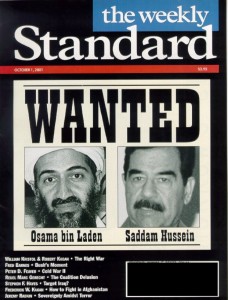
“The linking of the two evils. Unproven by the facts, reality in the image. The Wild West poster does the trick of validating the Bush approach and chosen iconography.”
The Better Rhetor builds on the work of Political Research Associates in this unpacking of the imagery used in a series of Weekly Standard covers.
See also Kate Brigham’s MFA thesis, Decoding Visual Language Elements in News Content, and its prototype Flash piece that allows you to alter design elements of post-September 11 news magazine spreads on the fly. See for yourself how non-verbal messages are expressed, the objectivity of the news is tilted, and the case for war is made by the choice of imagery, its cropping, composition, and color.
Thanks to drapetomaniac for the Better Rhetor link.
Visual Protest
- March 16: Over 6,400 candlelight vigils are held in 129 countries. See photos and an interactive map.
- March 17: Window Lights for Peace is launched. An extension of the vigil.
- March 18: Danish Prime Minister Anders Fogh Rasmussen in Parliament in Copenhagen, doused with red paint by a protestor over his government’s backing of U.S. military action on Iraq.
Whether
Why the urgent rush to war RIGHT NOW?
The longer the delay, the greater the risk of U.S. casualties.
From NBC 10:
“If Iraq is to be invaded, the greater the delay, the greater the potential problems. Temperatures that average 80 on April 1, rise to 110 in June, with some days as hot as 120.”
“A typical American soldier goes into combat with a heavy load, so if you send your troops into the Middle East during the warm part of the year, you are risking problems from heat stroke, sunstroke and all kinds of elements,” said Gregory Urwin of Temple University.
“The problem in fall is the combination of dry air and strong winds, which creates bad dust or sandstorms,” Schwartz said.
“It was a dust storm that brought down a helicopter that was part of the attempt to rescue the hostages in Iran.
“Weather and moon conditions are ideal right now. There is also something called moonrise and moonset. Even next week, there will be four to six hours of total darkness each night. The modern military may be less-dependant on moon phases than in the past, but if they wait too long, potential problems increase and ideal weather is unlikely until next winter.”
If the invasion is delayed just a few more weeks, perhaps it won’t actually happen...
Happy Water Power?
Hydroelectricity without the human rights and environmental disasters of dams? Maybe...
“Tidal energy exploits the natural rise and fall of coastal tidal waters caused principally by the interaction of the gravitational fields of the Sun and the Moon. Some coastlines, particularly estuaries accentuate this effect creating tidal ranges of up to 11m.”
Active tidal generators exist in Hammerfest in Norway, Annapolis in Canada, in France in the estuary of La Rance near St. Malo, and Kislaya Guba on the White Sea in Russia. This article summarizes a U.S. effort.
...
“Professor Thorstein Sigfusson, of the University of Iceland, says [the thermo-electric effect] works by translating the difference between the temperature of hot and cold water into energy....
In between the hot and the cold side are crystals made of semi-conductors. As the heat is transferred through these crystals part of it is converted from heat energy into electric energy.
Professor Sigfusson said there was potential for using all sorts of excess heat to fuel Thermators.” (BBC)
...
Japanese researchers are working on an experiemental power plant that produces both power and clean drinking water. From the New York Times:
“The university is preparing to build an experimental power plant off the coast of Palau that brings up cold seawater from the depths of the sea to an evaporator chamber near the ocean surface.
As the water is heated by the surrounding warm surface water, it releases ammonia gas, which then drives the system’s power generator...
Meanwhile, the heated water would be transferred to a separate low-pressure chamber where it boils at a lower temperature, producing steam, which would be condensed and collected as fresh water for human consumption, leaving salt crystals behind...
‘It works well especially in the western Pacific, where the temperature difference between the ocean’s surface and deep seawater is’ as much as 43 degrees Fahrenheit, he said. ‘It is environmentally sound.’”
Aussie Military Pulls College Ads over Parody
From The Sunday Mail:
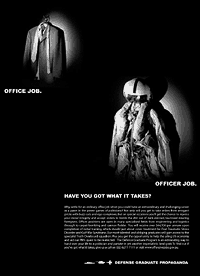 “[Australia’s] Department of Defence appears to have pulled all its advertising from every student newspaper in the country because one Sydney publication made fun of it.
“[Australia’s] Department of Defence appears to have pulled all its advertising from every student newspaper in the country because one Sydney publication made fun of it.
The University of Technology Sydney student newspaper Vertigo ran a satirical ad to counter recruitment advertisements appearing in other publications and voice the editors’ opposition to war on Iraq.
Under the heading, ‘Have you got what it takes?’, the ad reads:
‘Why settle for an ordinary office job when you could have an extraordinary and challenging career as a pawn in the power games of politicians?
‘Not only will you get to take orders from arrogant pricks with buzz-cuts and ego complexes, but on special occasions you’ll get the chance to repress your moral integrity and accept orders to bomb the shit out of dark-skinned, tea towel wearing foreigners.’
Vertigo editor Jano Gibson said that after seeing the ad, the Defence Department pulled all advertising from every student paper in the country.
The move comes at a time when many student newspapers are struggling for financial survival and increasingly reliant upon advertising.
But far from being disappointed, the editors are thrilled that they have eliminated all Defence ads, saying the Government had played right into their hands.
Mr Gibson said Vertigo had already refused ads from the department and was trying to get other student papers to do the same.
‘In effect the Department of Defence has fulfilled our intentions in having a boycott across the rest of Australia,’ he told AAP.
‘We see it as a great victory that students are no longer being inundated with false representations of the defence forces.’”
From the Sydney IndyMedia:
“As an act of solidarity the parody will also be reprinted by Rabelais, the student paper of La Trobe University, and Lot’s Wife, the student publication of Monash University, with more possibly to follow.”
Rating Congressional Web sites
The Congress Online Project today posted their report on second annual report on congressional Web sites. The report:
- Briefly describes the methodology and process we used to evaluate all 610 congressional Member office, standing committee, and leadership Web sites;
- Provides a detailed assessment of the overall performance of these sites;
- Identifies the 75 best Web sites on Capitol Hill — the Congress Online Gold, Silver, and Bronze Mouse Award winners — which can serve as models for offices wishing to improve their own sites;
- Identifies five fundamental building blocks for effective Web sites — and explains how offices can incorporate them into their own sites; and
- Describes the mistakes congressional offices are making with their online practices.
Lots of useful info here, though I wonder why the authors would talk to citizens to develop the methdology of the study, but not as part of the actual analysis itself.



